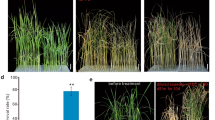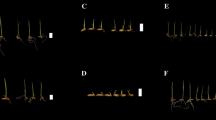Abstract
QTLs for salt-tolerance (ST) related traits at the seedling and tillering stages were identified using 99 BC2F8 introgression lines (IL) derived from a cross between IR64 (indica) as a recurrent parent and Binam (japonica) from Iran as the donor parent. Thirteen QTLs affecting survival days of seedlings (SDS), score of salt toxicity of leaves (SST), shoot K+ concentration (SKC) and shoot Na+ concentration (SNC) at the seedling stage and 22 QTLs underlying fresh weight of shoots (FW), tiller number per plant (TN) and plant height (PH) at the tillering stage were identified. Most QTLs detected at the tillering stage showed obvious differential expression to salt stress and were classified into three types based on their differential behaviors. Type I included 11 QTLs which were expressed only under the non-stress condition. Type II included five QTLs expressed in the control and the salt stress conditions, and three of them (QPh5, QPh8 and QTn9) had similar quantity and the same direction of gene effect, suggesting their expression was less influenced by salt stress. Type III included six QTLs which were detectable only under salt stress, suggesting that these QTLs were apparently induced by the stress. Thirteen QTLs affecting trait difference or trait stability of ILs between the stress and non-stress conditions were identified and the Binam alleles at all loci except QPh4, QTn2 and QFw2a decreased trait difference. The three QTLs less influenced by the stress and 13 QTLs affecting trait stability were considered as ST QTLs which contributed to ST. Comparing the distribution of QTLs detected at the seedling and tillering stages, most (69%) of them were genetically independent. Only four were the same or adjacent regions on chromosomes 1, 2, 8 and 11 harboring ST QTLs detected at the two stages, suggesting that partial genetic overlap of ST across the two stages occurs. It is likely, therefore, to develop ST rice variety for both stages by pyramiding of ST QTLs of different stages or selection against the overlapping QTLs between the two stages via marker-assisted selection (MAS).
Similar content being viewed by others
References
Yeo A R, Flowers T J. Salinity resistance in rice (Oryza sativa L.) and a pyramiding approach to breeding varieties for saline soils. Aust J Plant Physiol, 1986, 13: 161–173, 10.1071/PP9860161
Greenway H, Munns R. Mechanism of salt tolerance in nonhalophytes. Annu Rev Plant Physiol, 1980, 31: 149–190, 10.1146/annurev.pp.31.060180.001053, 1:CAS:528:DyaL3cXksVWntb4%3D
Shannon M C. Principles and strategies in breeding for higher salttolerance. Plant Soil, 1985, 89: 227–241, 10.1007/BF02182244
Lauchli A, Epstein E. Plant responses to saline and sodic conditions. In: Tanji K K, ed. Agricultural Salinity Assessment and Management. New York: Am Soc Civil Engrs, 1990. 113–137
Johnson D W, Smith S E, Dobrenz A K. Genetic and phenotypic relationships in response to NaCl at different developmental stages in alfalfa. Theor Appl Genet, 1992, 83: 833–838, 10.1007/BF00226705
Foolad M R, Lin G Y. Absence of a relationship between salt tolerance during germination and vegetative growth in tomato. Plant Breed, 1997, 116: 363–367, 10.1111/j.1439-0523.1997.tb01013.x, 1:CAS:528:DyaK2sXmvVagu7Y%3D
Foolad M R, Chen F Q. RFLP mapping of QTLs conferring salt tolerance during the vegetative stage in tomato. Theor Appl Genet, 1999, 99: 235–243, 10.1007/s001220051229, 1:CAS:528:DyaK1MXlvFGltb4%3D
Akbar M, Yabuno T. Breeding for saline-resistant varieties of rice: II. Comparative performance of some rice varieties to salinity during early development stage. Jap J Breed, 1974, 25: 176–181
Pearson G A. The salt tolerance of rice. Int Rice Commun Newsletter, 1961, 10: 1–4
Pearson G A, Ayers A D, Eberhard D L. Relative salt tolerance of rice during germination and early seedling development. Soil Sci, 1966, 102: 151–156, 10.1097/00010694-196609000-00003, 1:CAS:528:DyaF28XkvVGgsbs%3D
Flowers T J, Yeo A R. Variability in the resistance of sodium chloride salinity within rice (Oryza sativa L.) varieties. New Phytol, 1981, 88: 363–373, 10.1111/j.1469-8137.1981.tb01731.x, 1:CAS:528:DyaL3MXlt12ksL8%3D
Gong J M, He P, Qian Q, et al. Identification of salt-tolerance QTL in rice (Oryza sativa L.). Chin Sci Bull, 1999, 44(1): 68–71, 10.1007/BF03182889
Gu X Y, Mei M T, Yan X L, et al. Preliminary detection of quantitative trait loci for salt tolerance in rice. Chin J Rice Sci (in Chinese), 2000, 14(2): 65–70
Prasad S R, Bagali P G, Hittalmani S, et al. Molecular mapping of quantitative trait loci associated with seedling tolerance to salt stress in rice (Oryza sativa L). Curr Sci, 2000, 78: 162–164, 1:CAS:528:DC%2BD3cXhtV2gs7k%3D
Lin H X, Zhu M Z, Yano M, et al. QTLs for Na+ and K+ uptake of the shoots and roots controlling rice salt tolerance. Theor Appl Genet, 2004, 108: 253–260, 14513218, 10.1007/s00122-003-1421-y, 1:CAS:528:DC%2BD2cXjtFCntg%3D%3D
Koyama M L, Levesley A, Koebner R M et al. Quantitative trait loci for component physiological traits determining salt tolerance in rice. Plant Physiol, 2001, 125: 406–422, 11154348, 10.1104/pp.125.1.406, 1:CAS:528:DC%2BD3MXjslyls70%3D
Zhang G Y, Guo Y, Chen S L, et al. RFLP tagging of a salt tolerance gene. Plant Sci, 1995, 110(2):227–234, 10.1016/0168-9452(95)04219-K, 1:CAS:528:DyaK2MXotFCqtro%3D
Lee S Y, Ahn J H, Cha Y S, et al. Mapping of quantitative trait loci for salt tolerance at the seedling stage in rice. Mol Cells, 2006, 21(2): 192–196, 16682812, 1:CAS:528:DC%2BD28Xlt1Wjsro%3D
Sun Y, Zang J P, Wang Y, et al. Mining favorable salt-tolerant QTL from rice germplasm using a backcrossing introgression line population. Acta Agron Sin (in Chinese), 2007, 33(10): 1611–1617, 1:CAS:528:DC%2BD1cXht1aktrvI
Takehisa H, Shimodate T, Fukuta Y, et al. Identification of quantitative trait loci for plant growth of rice in paddy field flooded with salt water. Field Crops Res, 2004, 89: 85–95, 10.1016/j.fcr.2004.01.026
Yoshida S, Forno D A, Cock J H, et al. Laboratory Manual for Physiological Studies of Rice. 3rd ed. Manila: IRRI, 1976. 1–83
International Rice Research Institute. Standard Evaluation System for Rice. 4th ed. Manila: IRRI, 1996. 52
Temnykh S, Declerck G, Lukashova A, et al. Computationaland experimental analysis of microsatellites in rice (Oryza sativa L.): Frequency, length variation, transposon associations, and genetic marker potential. Genome Res, 2001, 11: 1441–1452, 11483586, 10.1101/gr.184001, 1:CAS:528:DC%2BD3MXlvVGgu70%3D
SAS Institute. SAS/STAT User’s Guide. NC: SAS Institute Cary, 1996
Li Z K, Yu S B, Lafitte H R, et al. QTL×environment interactions in rice. I. Heading date and plant height. Theor Appl Genet, 2003, 108: 141–153, 12961067, 10.1007/s00122-003-1401-2, 1:STN:280:DC%2BD3srnt1Skug%3D%3D
Xu J L, Lafitte H R, Gao Y M, et al. QTLs for drought avoidance and tolerance identified in a set of random introgression lines of rice. Theor Appl Genet, 2005, 111: 1642–1650, 16200414, 10.1007/s00122-005-0099-8, 1:STN:280:DC%2BD2MngtlOktA%3D%3D
Huang Y, Li L H, Chen Y, et al. Comparative analysis of gene expression at early seedling stage between a rice hybrid and its parents using a cDNA microarray of 9198 uni-sequences. Sci China Ser C-Life Sci, 2006, 49(6): 519–529, 10.1007/s11427-006-2031-0, 1:CAS:528:DC%2BD2sXitlOltQ%3D%3D
Gao H J, Yang R Q. Composite interval mapping of QTL for dynamic traits. Chin Sci Bull, 2006, 51(15): 1857–1862, 10.1007/s11434-006-2050-z
Kurata N, Nagamura Y, Yamamoto K, et al. A 300 kilobase interval genetic map of rice including 883 expressed sequences. Nat Genet, 1994, 8: 365–372, 7894488, 10.1038/ng1294-365, 1:CAS:528:DyaK2MXitl2hsLY%3D
Ware D, Jaiswal P, Ni J, et al. Gramene: A resource for comparative grass genomics. Nucleic Acid Res, 2002, 30: 103–105, 11752266, 10.1093/nar/30.1.103, 1:CAS:528:DC%2BD38Xht12kt7g%3D
Qian Q, Yanagihara S, Teng S, et al. Isolation, expression characteristics and chromosomal locations of three cDNA fragments under salt stress in rice. Acta Bot Sin, 2003, 45(9): 1090–1095, 1:CAS:528:DC%2BD2cXhtFGgurrP
Lang N T, Masood S, Yanagihara S, et al. Mapping QTLs for salt tolerance in rice. In: Khush G S, Brar D S, Hardy B. Advances in Rice Genetics. Supplement to Rice Genetics IV. Proceedings of the Fourth International Rice Genetics Symposium, 22∼27 October 2000. Los Banos: IRRI, 2003. 294–298
Badawi A T. Rice-based production systems for food security and poverty alleviation in the Near East and North Africa. Int Rice Comm Newsl, 2004, 53: 123–128
Xiao J, Yuan L P, Tanksley S D. Identification of QTLs affecting traits of agronomic important in a recombinant inbred population derived from a subspecific rice cross. Theor Appl Genet, 1996, 92: 230–244, 10.1007/BF00223380, 1:CAS:528:DyaK28XltFOjsLg%3D
He G M, Luo X J, Tian F, et al. Haplotype variation in structure and expression of a gene cluster associated with a quantitative trait locus for improved yield in rice. Genome Res, 2006, 16: 618–626, 16606701, 10.1101/gr.4814006, 1:CAS:528:DC%2BD28XkslCgsrY%3D
Lee S Y, Ahn J H, Cha Y S, et al. Mapping of quantitative trait loci for salt tolerance at the seedling stage in rice. Mol Cells, 2006, 21(2): 192–196, 16682812, 1:CAS:528:DC%2BD28Xlt1Wjsro%3D
Li Z K, Fu B Y, Gao Y M, et al. Genome-wide introgression lines and a forward genetics strategy for functional genomic research of complex phenotypes in rice. Plant Mol Biol, 2005, 59: 33–52, 16217600, 10.1007/s11103-005-8519-3, 1:CAS:528:DC%2BD2MXhtV2ksbbE
Xu J L, Gao Y M, Fu B Y, Li Z K. Indentification and screening of favorable genes from rice germplasm in backcross introgression populations. Mol Plant Breed (in Chinese), 2005, 3(5): 619–628, 1:CAS:528:DC%2BD28XpvVOjt7Y%3D
Ali A J, Xu J L, Ismail A M, et al. Hidden diversity for abiotic and biotic stress tolerances in the primary gene pool of rice revealed by a large backcross breeding program. Field Crops Res, 2006, 97: 66–76, 10.1016/j.fcr.2005.08.016
Author information
Authors and Affiliations
Corresponding author
Additional information
Contributed equally to this work
Supported by State “973” Programs from the Ministry of Science and Technology of China (Grant No. 2006CB100100), National High Technology Research and Development Program of China (“863” Program) (Grant No. 2007AA10Z191), and National Natural Science Foundation of China (Grant No. 30570996)
Rights and permissions
About this article
Cite this article
Zang, J., Sun, Y., Wang, Y. et al. Dissection of genetic overlap of salt tolerance QTLs at the seedling and tillering stages using backcross introgression lines in rice. SCI CHINA SER C 51, 583–591 (2008). https://doi.org/10.1007/s11427-008-0081-1
Received:
Accepted:
Published:
Issue Date:
DOI: https://doi.org/10.1007/s11427-008-0081-1




